- Home
- Various Articles - For Teacher Trainers
- Evaluating University Staff Teaching Capabilities Utilizing Associative Rule Analysis
Evaluating University Staff Teaching Capabilities Utilizing Associative Rule Analysis
Dr. Rasha Osman is an English language and literature assistant professor/lecturer at the American English Institute. She is a certified teacher from University of Oregon and Cambridge TESOL and avid researcher who presented in many national and international conferences. Dr. Rasha Osman has completed a number of training courses with the University of Massachusetts Lowell, Arizona State University, South Graduate Institute, and University of Oregon. She is highly interested in comparative literature, teaching adults, using technology and assessment issues.
Abstract
Evaluating faculty members’ performance is a very complex area to study. In addition, predicting the performance of these faculty members is highly challenging. However, the core of education is teaching and learning, and the teaching-learning works to its fullest when there are effective teachers. Student evaluation play a precise role in measuring the effectiveness of faculty members. The aim of this research is to develop a model to predict the performance of the faculty members using associative rule based on existing evaluation form used by Higher Technological Institute to evaluate faculty members. The model is designed to utilize the knowledge of text analytics rule capabilities that will provide a great support for decision making of Higher Technological Institute, Egypt. The result reveals that the term well is still the top one term used in all campuses followed by teaching. The results indicated that teacher/faculty members in all campuses are teachers who teach well. Associating words reveal that “teaching effective subject/topic”, “explain well” and other meaningful words that can be utilized to evaluate teacher performance. The results exposed not only the quantitative values of faculty evaluation it also exposed the qualitative opinion of the students in the performance of their faculty members. This study reveals important aspects of the faculty member’s teaching performance in terms of words / association of words that will describe their teaching performance. The results can be utilized in coaching / and mentoring faculty members in terms of their weaknesses. The proposed model can be utilized by Higher Technological Institute to evaluate their faculty members in terms of their teaching performance utilizing students’ comments.
Introduction
The core of education is teaching and learning, and the teaching-learning works to its fullest when there are effective teachers. To measure the effectiveness of teaching is through the use of student evaluation of faculty, a survey that students complete each academic semester. It is used to determine the perception and knowledge of faculty members on the different basic and fundamentals of teaching, research and service using the available resources [1]. This evaluative procedure is commonly referred to as student ratings of teaching (SRT), teacher rating form (TRF), student evaluation of teaching (SET), or student evaluation of faculty (SEF).
In Egypt, teacher evaluation is part of the educational institutions practice. The purpose of student evaluation of faculty is to facilitate faculty growth and development. Likewise, student evaluation is used to play a support tenure, promotion, transfer, and termination decisions as well as salary increases and faculty awards. In Egypt, improving quality of teaching performance, professional enhancement, and to make positive improvements among teachers constitute the main goals of teacher evaluation. [2-3]. The main objective of educational institutions is to provide quality education through regular teaching assessment to maintain quality of education [4]. According to Greenblatt [5] this criterion implies that the educational institution measures the quality of the services through the delivery of instruction to their students. Teaching is a development process which improves faculty performance or a reviewing process which assists administrators in making personnel and strategic decisions [6]. The main objective of faculty evaluation is to identify the strengths and work on the weak areas to improve the performance of the teachers, thus achieve optimum process quality. According to Sanders & Horn [6], once teachers are given feedback pertaining to classroom-level instructional outcomes, they start to modify their instruction to address their weak areas.
Evaluating teachers' performance is a difficult task, but it has been made for years through pedagogical surveys. The most commonly used tools to evaluate a teacher's performance is through surveying students' responses. The concern about student evaluations is based mainly on 1) students not having enough experience and maturity to evaluate the course and the teachers, 2) students' evaluation being affected by the popularity of the course and/or teacher, grades are given by the teacher and course being compulsory or elective. Furthermore, teacher may have the best performance on research to find out the solution for community problem, have good performance in community service, social life inside and outside the university [8]. In order to evaluate teacher's performance, students individually fill a pedagogical survey, and the quantitative mean of the answers corresponds to the teacher evaluation. However, despite the spread of such tools, there is no study that can automatically predict teachers' performance using qualitative surveys that will directly identify the strength and weakness of a teacher [3]. Nowadays, data mining is becoming a more common platform in understanding and solving educational and administrative problems in higher education. Data mining techniques are applied in higher education more and more to give insights to educational and administrative problems in order to increase the managerial effectiveness. However, most of the researches carried out on educational mining focuses mainly on modeling student's performance and a very small number of research model on faculty performance. [10-13].
Data mining is a powerful technology for analyzing important information from the data warehouses. It is a data analysis methodology used to identify hidden patterns in a large set of data [2]. With data mining techniques, such knowledge can be extracted and accessed in transforming the database tasks from storing and retrieval of learning and extracting knowledge. It consists of a set of techniques that are used to extract relevant and interesting knowledge from data. Data mining has several tasks such as association rule mining, classification and prediction, and clustering. Classification techniques are supervised learning techniques that classify the data item into the predefined class label. It is made of the most useful techniques in data mining to build classification models from an input data set. It is the process of finding a set of models that describe and differentiate data classes and concepts, for the purpose of predicting the class whose label is unknown [9]. The users commonly build models used to predict future data trends. There are several algorithms for data classification such as decision tree (j48), Support Vector Machines (SVM), and Naive Bayes classifiers. With classification, the generated model would be able to predict a class for giving data depending on previously learned information from historical data [4].
The aim of this research is to develop a model to predict faculty teaching capabilities using associative rule based on existing evaluation form use by Higher Technology Institute to evaluate faculty members. The study aimed to:
- to determine the most frequent word/words to describe the way faculty members perform
- to determine the performance of faculty members of the selected faculties campuses of Higher Technological Institute using the associative approach text analytics technique.
The proposed model is designed to utilize the knowledge of associative text analytics capabilities that will provide a great support for decision making of Higher Technological Institute.
Materials and methods
Data collection
The first step in this paper that needs to be accomplished is to gather all the necessary data. Data for this study are the comments from the evaluation rating of the teaching staffs of Higher Technological Institute. Data were collected from the Online Portal. Questionnaires were sent to each students’ portal and gave them the opportunity to evaluate the performance of their instructors. Name of faculty member, subject taught that semester (First Semester, A.Y. 2020 - 2021), and comments were gathered. Most of the comments are in English language. Comments that are written in Arabic were also included. The estimated number of data gathered is 10, 408.
Table1
Sample Comments from Actual Data set with Number of Language or Dialects Used
|
Number of Language Used |
Comments |
|
One (English) |
She teaches well. She does everything to help us all topics that she discuss. Sometimes she is late because of first subject she handle but we understand that because she wants us/them learned more about the topics she gave |
|
One(Arabic) |
تشرح جيداً وتفعل ما وسعها لتسهيل المادة |
|
Two (English-Arabic) |
She is an expert in her course and makes things easy. تشرح جيداً وتفعل ما وسعها لتسهيل المادة |
Data translation was then employed after the data were compiled. Comments that are written in Arabic were translated to English language. Fill-in the missing values from the comments such missing letter/s were next employed. Lastly, inconsistencies such as misspelled words or mistakes in grammar were then resolved. These processes were accomplished by the data processor.
Data pre-processing
Data pre-processing was immediately employed after cleaning the data gathered. Data preprocessing operators include tokenization, filtering stop words, stemming, case transformation and feature selection or n-gram. Translation, tokenization, case transformation, and filtering stop words are the only data preprocessing steps that were employed.
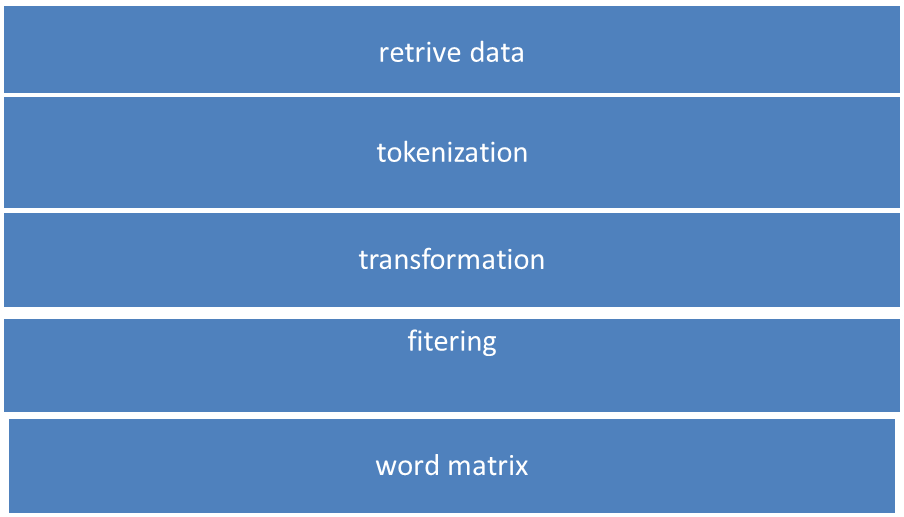
Tokenization is the first process employed under the data preprocessing procedure. This operator break up the text of a document into pieces of words, keywords, symbols, and other similar things called tokens. There are several options that can be used in breaking up the text, but the default setting which is the non-letters was employed in this paper. This operation transforms the cases of letters from lower case to upper case or vice versa. In this paper, all letters in the data were transformed into lower case for the purpose of convenience and at the same time avoiding mix-ups.

Saved Text File of Stopwords
The final pre-processing step employed is the Filter Stopwords (Dictionary) operator. This is done to remove all the tokens equal to the stopwords from the given text file and can be accomplished by listing down words that are assumed to be unnecessary. Another option is to download text file or document file containing pre-identified English stopwords via Internet. Take note that if the document is not in text file format, then it must be converted into that format because it is the must-be-done requirement of RapidMiner9.7. The latter option was employed and verified the content just in case that there are words that needed to be included or removed. In this paper, adjectives and some pronouns (such as he and she) were not included in the list of stopwords.
Table 2.
The Before and After Using Translation and Data Preprocessing
|
Process |
Before |
After |
|
Translation |
She has good teaching skills.
|
She has good teaching skills. I understand what she teaches. Sometimes busy that's why we can't meet but it's okay. |
|
Transform Cases |
She has good teaching skills. I understand what she teaches. Sometimes busy that's why we can't meet but it's okay. |
she has good teaching skills. i understand what she teaches. sometimes busy that's why we can't meet but it's okay. |
|
Tokenization |
she has good teaching skills. i understand what she teaches. sometimes busy that's why we can't meet but it's okay. |
she has good teaching skills i understand what she teaches sometimes busy that’s why we cant meet but its okay |
|
Stopwords (Dictionary) |
she has good teaching skills i understand what she teaches sometimes busy that’s why we cant meet but its okay |
she good teaching skills understand she teaches busy cant meet okay |
The tokenization, case transformation, and filtering stop words were done using the RapidMiner .
Vector creation
The schema used in vector creation was TF-IDF or Term Frequency – Inverse Document Frequency. This schema is a numerical statistic which shows the importance of a word is to a document in a corpus and considered as the most popular weight schema. In this schema, the TF-IDF value is directly proportional to the incidence of documents in the corpus that contain the word or term. Hence, as the word or term occurs most often, the value increases. The TF-IDF will choose those words that weighted a greater importance based frothe dataset. The TF-IDF value increases proportionally to the number of times a term appears in the document, but is offset by the frequency of the word in the corpus. It helps to control or adjust because some terms are generally more common than others.
Pattern recognition
The method that was applied in determining the pattern recognition of comments was the Association Rule Mining. In Association Rule Mining, all itemsets must meet the set value for minimum threshold for support and confidence to arrive at a strong relationship between or among items. The formula for computing the support and confidence are given below:
SUPPORT = occurrences of [A, B] / total number of transactions (1)
CONFIDENCE [A,B] = occurrences of [A,B] / total number of [A] (2)
Frequent item sets are quantified by support which is defined as the ratio between the number of instances where [A, B] appeared together in a single transaction and the total number of transactions. On the other hand, confidence is the probability of finding [item A, item B] together.
This paper used two-step process in analyzing the comments. The first step includes conducting comment word analysis using FP – Growth in terms of frequent patterns of item sets. The value set for the minimum frequency for overall data (i.e., compiled data of every campus) is different for the per campus data. The value set for the overall data is 67 and for per campus differs depending on the data set. The second step includes the examination and determination of the strong relationship between a pair of words using the Create Association Rules. The criterion used is the confidence and the threshold value set for confidence is 0.90.
Flow chart
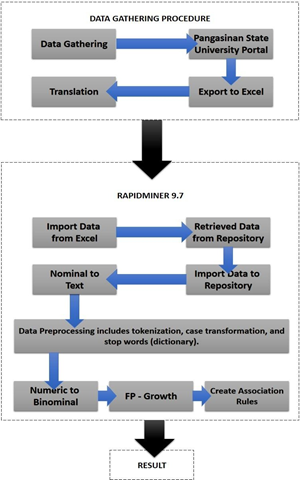
The figure above shows the process that was employed from data gathering up until the use of RapidMiner to arrive at the desired results.
Results and discussion
Descriptive results
This subsection includes the terms with the highest frequency under the overall data set.
Table 3. Most Occurred Terms for the Overall Data Set
|
Word |
Rank |
|
Good |
1 |
|
Teaching |
2 |
|
Students |
3 |
|
Topic |
4 |
|
Understand |
5 |
|
Class |
6 |
|
Time |
7 |
|
Teach |
8 |
|
topics |
9 |
|
teacher |
10 |
Based from the overall data, the term that occurred the most is good. Identifying the rank of the top 10 terms provided above with respect to per campus provides a deeper understanding on the data set.
Table 4.
Top 10 most Occurred Terms for the Overall Data Set compared to per Campus Data Set
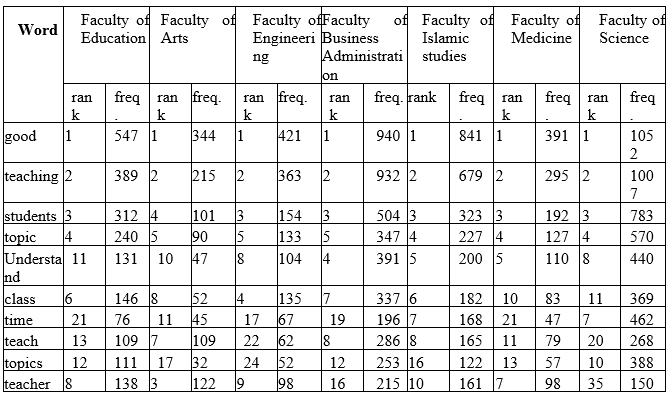
It can be reflected that the term good is still the top one terms occurred for all campuses. The Faculty of Education Campus almost reflected the actual rankings for the overall data set except for the term topics. The Table 4.2 gives us the idea on the terms mostly used by the students per campus when giving comments on the performance of the faculty members. Say for example, the term teacher under the Faculty of Science Campus is ranked number three, which has a relatively higher rank compared to the other remaining campuses, tells us that most of the students on this campus gives greater importance on the usage of this term.
Pattern recognition using FP - Growth
This research paper applied FP – Growth to determine the frequent patterns in the data set. This operator efficiently calculates all frequent itemsets from the given ExampleSet using the FP-tree data structure. It is necessary that all attributes of the input ExampleSet should be binominal.
FP – Growth has two basic working modes in identifying the most frequent itemset/s: (1) Looking for the least specified number of itemsets with highest support without considering the 'minimum support', and (2) looking for every itemsets with a support larger than the specified minimum support. This approach uses the FP-Tree algorithm which encodes the data set into a tree and then extracts the frequent itemsets from this tree. Basically, frequent itemsets are groups of items that often appear together in the data. Using the Rapid miner 9.7, the dataset were generated and calculated based on FP - Growth method. The most frequent items and itemsets were displayed in table 5.
Table 5. Result After Using FP - Growth for the Overall Data Set
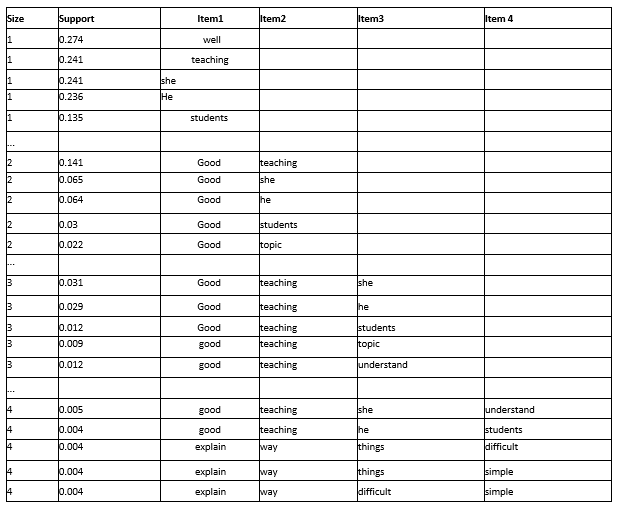
The most frequent itemsets occurred are the following: itemset good and teaching for size 2 with a support equal to 0.141; itemset good, teaching, and she for size 3 with a support equal to 0.031; and itemset good, teaching, she, and understand for size 4 with support equal to 0.005. For example, the terms good and teaching are the most common terms used in the comments on the performance of the faculty members, that is, this itemset occurs 1,410 times for every 10,000 comments. Another, the itemset containing terms explain, way, things, and difficult means that it occurs 40 times for every 10,000 comments. The results in this section is useful in considering the rules that are worthy for further analysis. The FP -Growth results per campus are provided below:
Table 6.
Result After Using FP - Growth for the Faulty of Education Data Set (min freq = 10, min items=1, max items = 5)
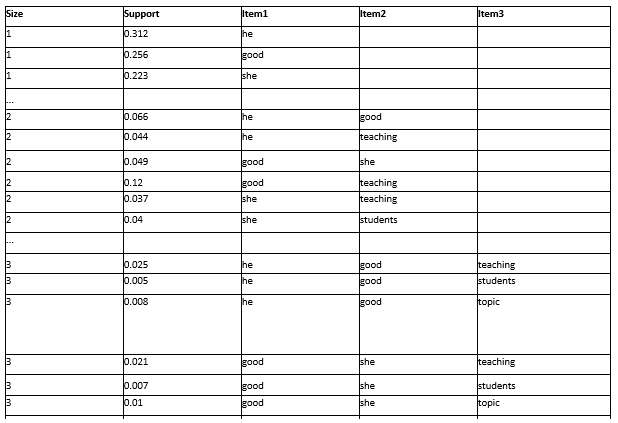
Table 7. Result After Using FP
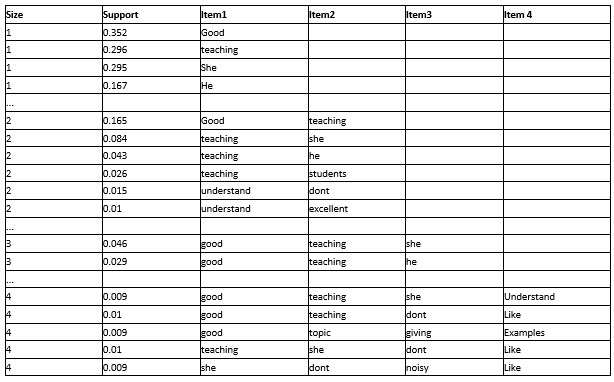
Table 9. Result After Using FP - Faculty of Business Administration Set
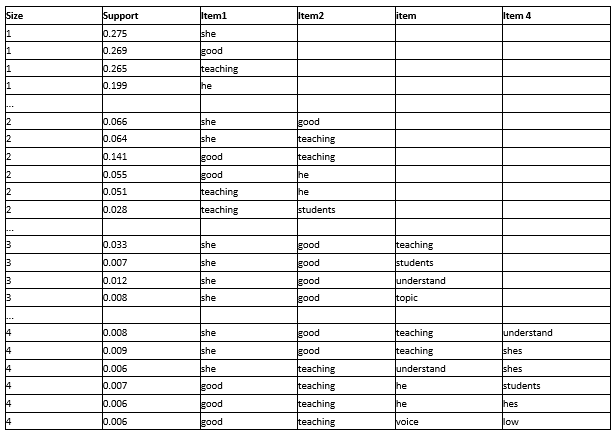
Table 8.
Result After Using FP - Growth for the Faculty of Islamic StudiesTable 9. Result After Using FP - Growth for the Faculty of Medicine Data Set
(min freq = 22, min items=1, max items = 5)
|
3 |
0.027 |
good |
He |
students |
|
|
3 |
0.023 |
good |
He |
topic |
|
|
3 |
0.075 |
good |
Teaching |
she |
|
|
3 |
0.032 |
good |
Teaching |
students |
|
|
3 |
0.027 |
good |
Teaching |
student |
|
|
3 |
0.031 |
good |
Teaching |
kind |
|
|
3 |
0.027 |
good |
Teaching |
attention |
|
|
3 |
0.023 |
good |
Teaching |
abuse |
|
|
3 |
0.023 |
good |
She |
students |
|
|
3 |
0.023 |
good |
Kind |
abuse |
|
|
3 |
0.025 |
good |
Attention |
catch |
|
|
3 |
0.023 |
he |
Teaching |
kind |
|
|
3 |
0.027 |
he |
Topic |
understand |
|
|
3 |
0.023 |
teaching |
Kind |
abuse |
|
|
4 |
0.023 |
good |
Teaching |
kind |
abuse |
Table 10. Result After Using FP
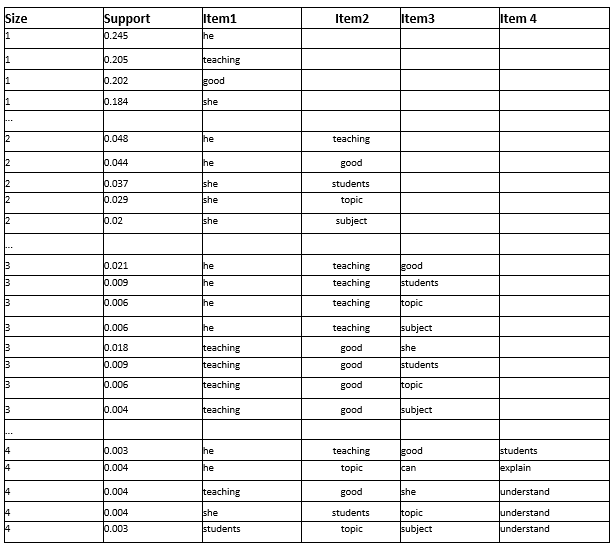
Pattern recognition by creating association rules
Create Association Rules that is based on market basket analysis was used for pattern recognition. This operator generates a set of association rules from the given set of frequent item sets. This technique is often applied in supermarket and other shopping industries to identify the trending items which are purchased together, thus, contributing to the possible increase in profit of the said businesses by determining the items that are subject for optimization or mass production. When this method is applied to text mining, each term is considered as items and the text field is the transactions. Hence, the goal is to further identify the terms that occur together that will give us the overview on the perspective of the students towards their instructors. Applying the create association rules operator gives a clear view and understanding on the terms that have strong relationship with each other and are commonly used together by the students in giving comments or evaluation to the faculty members. The complete result for the overall data set.
A total of 13 rules were derived where in each numerical value for confidence exceeds the set threshold value (minimum confidence is 0.90) after applying the Create Association Rules operator under the Rapid Miner. This implies that the terms included in Table 4.11 have strong relationship within each other. For example, the terms way and difficult are strongly related with the terms explain and simple with support equal to 0.004373834 and a confidence equal to 0.944444444. Also, if way and difficult (premise) were included in the comment, then there is a high possibility that the terms explain and simple (conclusion) will also appear. It is not appropriate to say that when explain and simple (conclusion) occurred in the comment because of the existence of way and difficult in the same comment. Take note that Association Rules are not consequential instead they are co-existential, that is, when the premise occurred, then the conclusion will also occur at the same time. This is also due to the fact that the result has low support value but with high confidence value. Further, this implies that the rules might not stand out in the data set but it occurred frequently due to continued analysis. The same explanation goes for the rest of the rules included in the list.
Conducting the same Association Rule process per campus gives us the idea on the usual characteristics of its faculty members based on how the students perceived them. For Faculty of Education, if lessons and explaining (premise) were included in the comment, then there is a high possibility that the term good (conclusion) will also appear, hence most of the students perceived their instructors are good in explaining the lessons and critiqued them based on their teaching strategies. Also, if the term loud were in the comment, then there is a high possibility that the term voice will follow. This implies that students thought that their instructors are loud-voiced that may indicate whether resounding and clear (positive) or piercing (negative). For Faculty of Education majority of the students gave critic to their instructors through their communication and social skills due to the fact that these terms have strong relationship within each other. Faculty of Education is best known for its teacher education program having been granted by King Saud University in order to maintain the excellence and quality teaching. For Faculty of Arts, the students perceived their instructors as good in discussing topic. This might imply that students are satisfied with the teaching methods employed, and the knowledge and pieces of information delivered by their instructors. Also, students perceived their instructors as understanding especially when it comes to the situation of their students. The only downfall is that students deemed their instructors with low voice quality, hence, it explains why they don’t like noise particularly for female instructors due to relationship between the terms she, noisy, like to don’t.
For Faculty of Engineering, if the terms good, teaching, and low appeared in the comment, then the term voice will appear at the same time. This implies that majority of students recognized their instructors as good in teaching but with low voice, especially when the instructor is female because of the strong relationship between the terms she, low and voice. Also, the terms loud and voice appeared on the result asserts the existence of instructors that possess audible voice. Just like in Faculty of Business Administration, this may indicate whether resounding and clear (positive) or piercing (negative). The ambiguity of the usage of loud and voice possibly due to the insufficiency of objects and complements in the comments of the students, thus, majority of the comments are deemed as incomplete sentences.
For Faculty of Islamic Studies, most of the students perceived that their instructors can explain difficult topics, lessons, and other similar things in a simple way due to the fact that the terms simple and way has a strong relationship, also the itemset simple, way, difficult, and explain has strong relationship. This is a good skill for any educator in ensuring the in-depth understanding and easy acquisition of knowledge and pieces of information to the students. Furthermore, this implies that the instructors have a well enough understanding on the topics and lessons they are teaching due to the fact that their students deemed that they can explain things in a simple manner.
For Faculty of Medicine, the students perceived their instructors as good in teaching just like the other campuses but abused for being kind. This might indicate that the students recognized the kindness and potential of their instructors in teaching but their kindness made them vulnerable to abuse which imposes a serious concern. One of the things that an educator must possess is the ability to assert authority inside the classroom. It is believed and through experiences that too much authority inside the classroom affects the learning of the students and impedes innovation and feedback on the part of the students that is why instructors need to set boundaries on when to show kindness and when to impose strict authority. Thus, instructors in this campus should exercise balancing between imposing authority and applying student-centered approach.
Lastly, for Faculty of Science, most of the students perceived their instructors as good in relating topics in real life situations and in-depth subject matter. This might indicate that the instructors are good in using analogy in discussions, hence, this further indicates their thorough understanding on the subject matter they are teaching. Another, students recognized their instructors whether loud-voiced or soft-voiced akin to Lingayen Campus. Also, instructors are deemed by students as late in class or tardy. Tardiness in work implies irresponsibility and unreliability. Tardiness of instructors promotes disinterest in the students, worse, truancy or absenteeism on the part of students. Instructors must ensure their attendance and punctuality in class to set a good classroom environment and to serve as an exemplar for the students.
It is meaningful and just to introduce another parameter since the support value is low with high confidence value to measure the effectiveness of the association rules - which is the lift. The lift is the ratio between the support and the product of the probabilities of the premise and the conclusion (or the left and right hand side) occurring assuming that there is no association between them or independent from each other. The lift measures the strength of the association between the premise and conclusion, hence the larger the value of the lift the stronger the association between them. A lift value equal to 1 suggest that there is no meaningful association between the premise and conclusion. Notice that every lift value of each of the following derived rules is greater than 1, thus, there is a strong association between the premise and conclusion. The top three rules with the strongest association per campus are highlighted in yellow.
Conclusions
The aim of this research is to develop a model to predict the performance of the faculty using associative rule based on existing evaluation form use by Higher Technological Institute to evaluate faculty members. The study aimed to:
- To determine the most frequent word/words to describe the performance of a faculty member.
- To determine the performance of faculty members of every campus of the Higher Technological Institute using the associative approach text analytics technique.
The proposed model is designed to utilize the knowledge of associative text analytics capabilities that will provide a great support for decision making of Higher Technological Institute. The result reveals that the term good is still the top one terms occurred for all campuses followed by teaching. The results indicated that teacher/faculty members in all campuses are good teachers. Associating words reveal that “teaching good subject/topic”, “explain simple” and other meaningful associated words that can be utilized to evaluate the performance of the teacher. The results exposed not only the quantitative values of faculty evaluation it also exposed the qualitative opinion of the students in the performance of their faculty members.
This study reveals important aspects of faculty member’s teaching performance in terms of words / association of words that will describe their teaching performance. The results can be utilized coaching / and mentoring by faculty members in terms of their weaknesses. The proposed model can be utilized by Higher Technological Institute to evaluate their faculty members in terms of their teaching performance utilizing the comments / opinions of the students.
References
- J. P., Sampson, , M. P. Driscoll, D. F. Foulk, & P.S. Carroll Successful faculty performance in teaching, research and original creative work, and service, 2010.
- N. Temmerman, Transforming higher education in Vietnam. University World News. https://www.universityworldnews.com/post.php?story=20190129142655883, (2019, February 1).
- G.W. Fry. Higher Education in Vietnam. In: Hirosato Y., Kitamura Y. (eds) The Political Economy of Educational Reforms and Capacity Development in Southeast Asia. Education in the Asia -Pacific Region: Issues, Concerns and Prospects, vol 13. Springer, Dordrecht. https://doi.org/10.1007/978-1-4020-9377-7_14, 2009.
- A.K. Pal, and S. Pal, Evaluation of Teacher's Performance: A Data Mining Approach. International Journal of Computer Science and Mobile Computing. Vol. 2 Issue 12, Page 359 – 369, 2013.
- Greenblatt, D. (2016). The consequences of edTPA. Educational Leadership, 73(8), 51-54.
- Guerriero, S. (2014). Teachers’ pedagogical knowledge and the teaching profession. Teaching and Teacher education, 2 (1), 7.
- Stanford Center for Assessment, Learning and Equity (SCALE). (2015). Making good choices: A support guide for edTPA candidates. Retrieved on December 11, 2015 from: https://www.edtpa.com/Content/Docs/edTPAMGC.pdf
- Fite, D. (2006). Using evaluation data for personnel decisions. . In Seldin, P. & Associates (2006) Evaluating Faculty Performance: A Guide to Assessing Teaching, Research, and Service. Bolton, MA: Anker Publishing Company, Inc.
- Peterson, K. D., & Peterson, C.A. (2006). Effective Teacher Evaluation – A Guide for Principals. Corwin Press.
- Beran, T. y Violato, C. (2005). Rating of university teacher instruction: How much do student and course characteristics really matter? Assessment and Evaluation in Higher Education, 30, 593‐601.
- Goldhaber, Dan, and Michael Hansen. 2010. “Assessing the Potential of Using Value-Added Estimates of Teacher Job Performance for Making Tenure Decisions.” National Center for Analysis of Longitudinal Data in Education Research Working Paper 31.
- A. Mustafa, Predicting Instructor Performance Using Data Mining Techniques in Higher Education, 2016.
- S. Badur and B. Badur, Analyzing teaching performance of instructors using data mining techniques, 2011.
- R. S. J. D. Baker and K. Yacef, "The state of educational data mining in 2009: A review and future vision", J. Edu. Data Mining, -vol. 1, no. 1, pp. 3_17,2009.
- F. D. Kentli and Y. Sahin, "An SVM approach to predict student performance in manufacturing processes course", Energy, Edu., Sci. Technol. B, vol. 3, no. 4, pp. 535_544, 2011.
- A. Pena-Ayala, "Review: Educational data mining: A survey and a data mining-based analysis of recent works", Expert Syst. Appl., vol. 41, no. 4, pp. 1432_1462, 2014.
- J. Zimmerman, K. H. Brodersen, H. R. Heinimann, and J. M. But-unarm, "A model-based approach to predicting graduate level performance using indicators of undergraduate-level performance", J. Edu. Data Mining, vol. 7, no. 3, pp. 151_176, 2015.
Please check the Pilgrims f2f courses at Pilgrims website.
Please check the Pilgrims online courses at Pilgrims website
Applying TESOL Methodology Not Only to Business English Classes Within the Learner-centred Approach
Katarína Zamborová, SlovakiaEvaluating University Staff Teaching Capabilities Utilizing Associative Rule Analysis
Rasha Osman Abdel Haliem Osman, Egypt